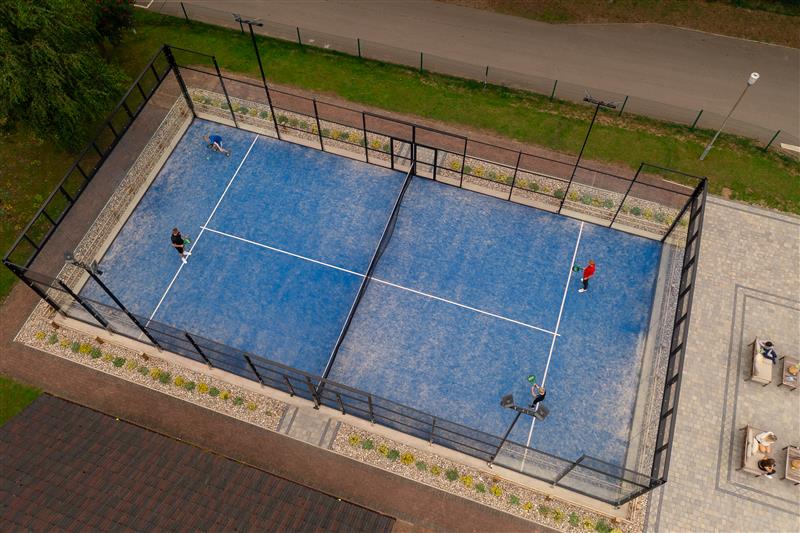
, Posted on Wednesday August 14, 2024
Everything You Need to Know About Padel Tennis
Table of contents
- What is padel tennis?
- Padel tennis court
- Padel tennis equipment
- Padel tennis rules
- The Aesthetics of Padel Tennis
- Padel tennis physical benefits
5 minutes read time
Padel tennis has been sweeping across Europe, and here in the UK there are more and more people taking up this exciting racket sport. Recently, Don Amott Parks opened a ‘competition size’ padel tennis court at Nettleton in Lincolnshire. Our new facility joins the already existing court at Lakeside and makes these the only padel tennis courts at holiday parks in Lincolnshire. To maximise padel tennis enjoyment for all, in this edition of our blog we present a beginner’s guide. We’ll cover everything you need to know about the game, from the basic rules to the social and physical benefits.
What is padel tennis?
Padel tennis is a racket sport that combines elements of tennis, squash and badminton. It’s typically played in doubles (i.e. two players per team), though singles matches can also be played but are less common. Padel tennis is currently most popular Latin America and Spain, but its popularity is increasing quickly in other parts of the world – including the UK. It is also often simply referred to as ‘padel’.
Padel tennis court
One of the defining features of the game of padel tennis is the enclosed court it’s played on. Surrounded by glass or plastic solid 10 feet high walls, the court measures approximately 32 feet by 64 feet (10 metres by 20 metres, about half the size of a standard tennis court). The net that divides the court in half is a touch under 3 feet high at the centre (88cm, slightly lower than a tennis net). The playing surface of a padel tennis court can vary, with a type of artificial turf being the most common.
Padel tennis equipment
The padel racket is distinct from the type of racket used in tennis or squash. It’s smaller and doesn’t have strings – instead it’s perforated with holes. Made of composite materials, a padel tennis racket is solid with a short and ergonomically designed handle. The ball used in padel is similar to a tennis ball but with slightly less pressure, which means its bounce and speed are different.
Padel tennis rules
The rules of padel tennis are straightforward, which means that it’s an accessible game, even to players who are new to racket sports.
- Serving: The game starts with an underhand serve, which must be hit below waist height and diagonally into the opponent’s service box. The server has to let the ball bounce once before they can hit it, and they must keep both feet behind the service line.
- Gameplay: Once the ball is in play it must bounce only once on the ground before being returned, but players are allowed to hit the ball after it bounces off the walls or before it reaches the wall. Padel players use the walls surrounding the court to their advantage (similar to squash) and can keep the ball in play by hitting it off the walls. This sort of play adds a whole new strategic dimension to the game which is not seen in the standard form of tennis, as players must anticipate angles and rebounds. Positioning and footwork becomes even more crucial.
- Scoring: Padel tennis uses exactly the same scoring system as ‘regular’ tennis. The score increases at 15, 30, 40 and then game (with the possibility of deuce at 40-40 and advantage as a step towards deciding the outcome). Padel tennis matches are usually played as best of three sets.
- Winning a point: A point is won when the ball bounces twice in the opponent’s court, or they hit the ball out of bounds (including hitting the glass walls without the ball first bouncing on the court), or when the opponent fails to return the ball or hits the net.
The Aesthetics of Padel Tennis
The atmosphere on a padel court is typically energetic and enthusiastic. Games tend to be fast-paced with quick reflexes, agility and a decent sense of strategy being required to play well. Despite its intensity, however, players of all ages and skill levels can enjoy as padel tennis is a very friendly and social game. It’s often referred to as a social sport because of the emphasis on fun and interaction rather than just competition.
One of the key factors behind the growth of it in recent years is its social nature. Since it’s typically played in doubles, it’s a game which encourages teamwork and constant communication. It’s common for friends and family to play together. Padel tennis is also popular in social settings, such as leisure centres and holiday parks like Nettleton and Lakeside. Padel is quite easy to pick up, making it ideal for gatherings and community events.
At an aesthetic level padel tennis offers a pleasing gameplay environment – appealing to both players and spectators. The enclosed court, often surrounded by glass, is a compact space that intensifies action, allowing spectators to enjoy an exciting close-up view of the game. The use of artificial turf adds a modern, sleek look to the court, often in vibrant colours that make it visually appealing.
Padel tennis physical benefits
Padel tennis offers numerous physical benefits, so it’s an excellent choice for those players who are playing it with the aim of setting or staying fit and active.
- Cardio and endurance: The fast-paced nature of padel tennis provides an excellent cardiovascular workout. The short bursts of speed, quick changes of direction, and the need to cover the court rapidly all contribute to better cardiovascular health. Players can also burn a significant number of calories during a match, making it an effective form of exercise for weight management and overall fitness.
- Agility and reflexes: The enclosed padel tennis court and the use of walls in play mean that the ball can come from any direction at any time. This requires players to have sharp reflexes and quick decision-making skills. The constant need to reposition the body and anticipate the opponent’s moves helps to improve agility and hand-eye coordination.
- Strength and flexibility: Although padel tennis might not be as physically demanding as some other sports, it’s still quite demanding! It requires a good level of strength and flexibility. The repetitive swinging of the racket helps to build upper body strength, particularly in the arms and shoulders and the lunges and quick movements involved in reaching the ball can help to improve lower body strength and flexibility.
- Mentality: Padel tennis is as much a mental game as it is a physical one. Players need to constantly think ahead, strategising their shots and formulating a plan for play, as well as anticipating their opponent’s next move. This mental engagement during play can help improve concentration and cognitive function, making padel tennis not just a workout for the body but also for the mind.
Padel tennis is a dynamic, fun and social sport that offers something for everyone. Playing it at our Nettleton or Lakeside parks provides you with the opportunity to enjoy one of the world’s fastest growing sports, amidst all of the other facilities available on those parks. Whatever your reason for playing – a new way to stay fit, something to play with friends and family or a competitive outlet – padel tennis has it all.


